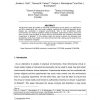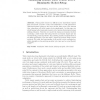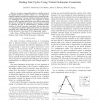118 search results - page 12 / 24 » Why computerized models to control virtual Humans |
VR
2011
IEEE
12 years 11 months ago
2011
IEEE
—Redirected walking (RDW) techniques allow people to walk in a larger virtual space than the physical extents of the laboratory. We describe two experiments conducted to investig...
PSYCHNOLOGY
2008
13 years 7 months ago
2008
Virtual/mixed reality 3D models of real-world environments can be used to run behavioural and other experiments with real human subjects, replacing the traditional approach where ...
SAB
2010
Springer
13 years 6 months ago
2010
Springer
Playing table tennis is a difficult motor task which requires fast movements, accurate control and adaptation to task parameters. Although human beings see and move slower than mos...
IVA
2009
Springer
14 years 2 months ago
2009
Springer
Abstract. The challenge of making a virtual world believable includes a requirement for AI entities which autonomously react to a dynamic environment. After the breakthroughs in be...
CDC
2008
IEEE
14 years 2 months ago
2008
IEEE
— A planar compass-like biped on a shallow slope is the simplest model of a passive walker. It is a two-degrees-offreedom impulsive mechanical system known to possess periodic so...



